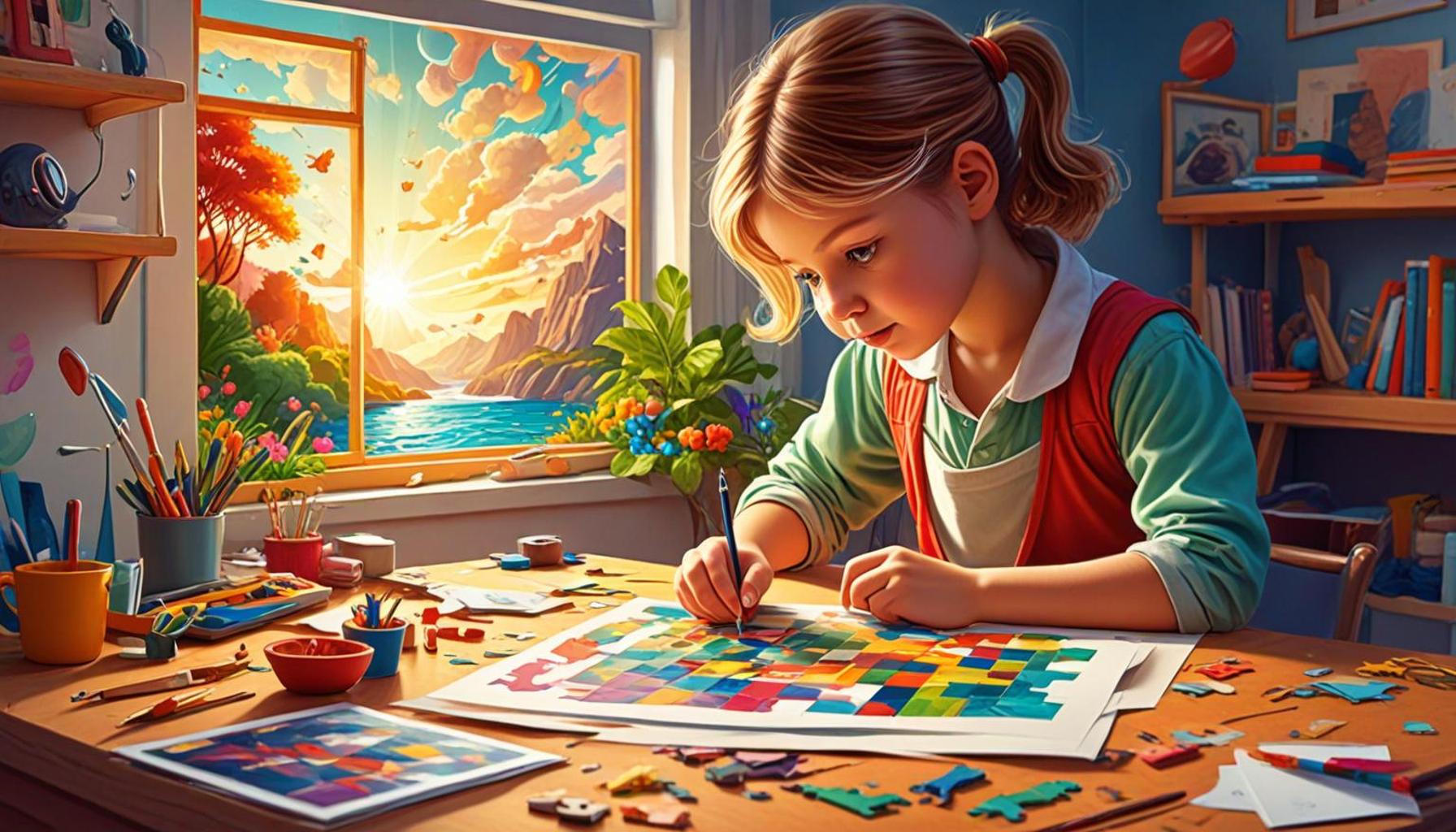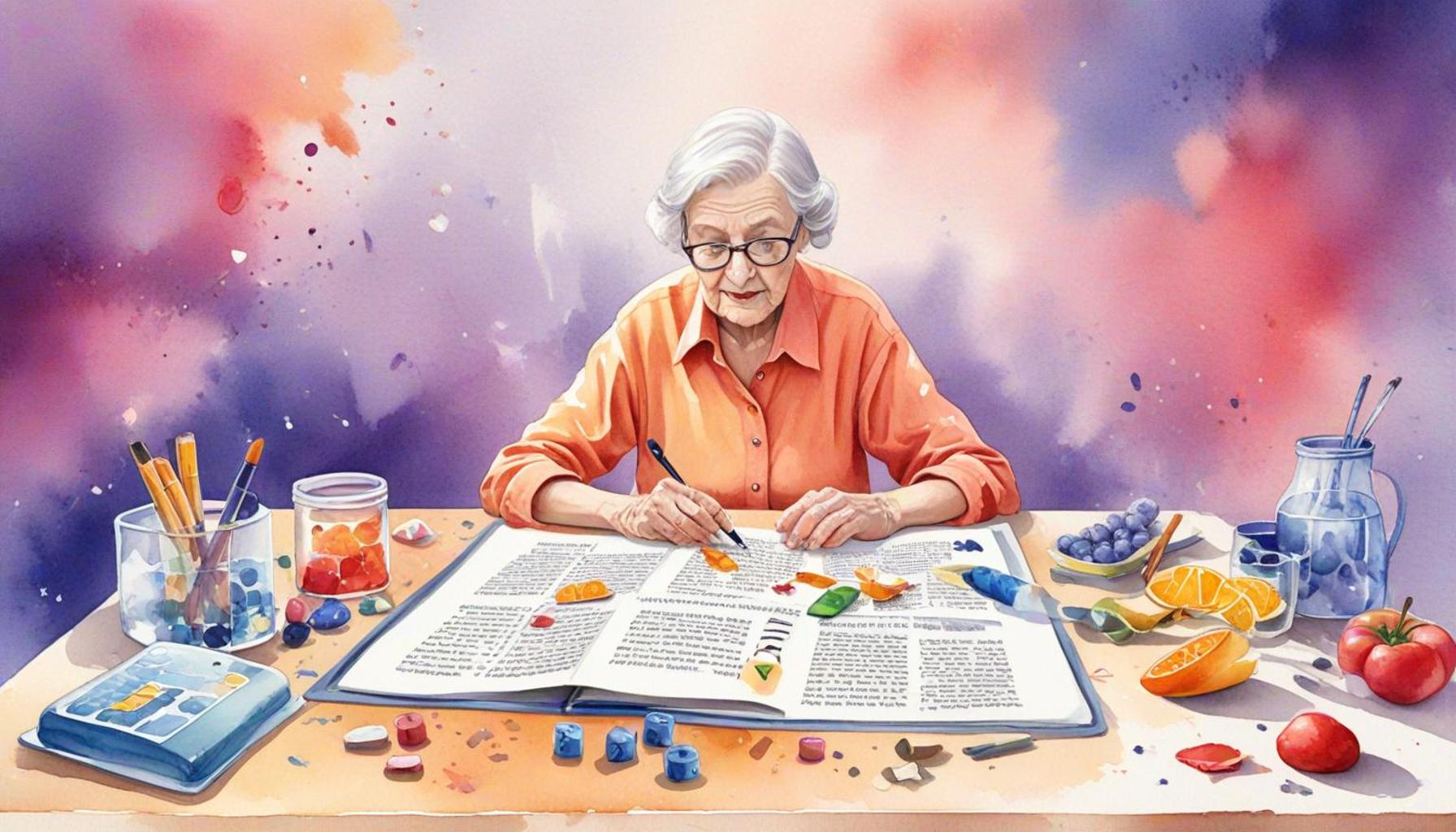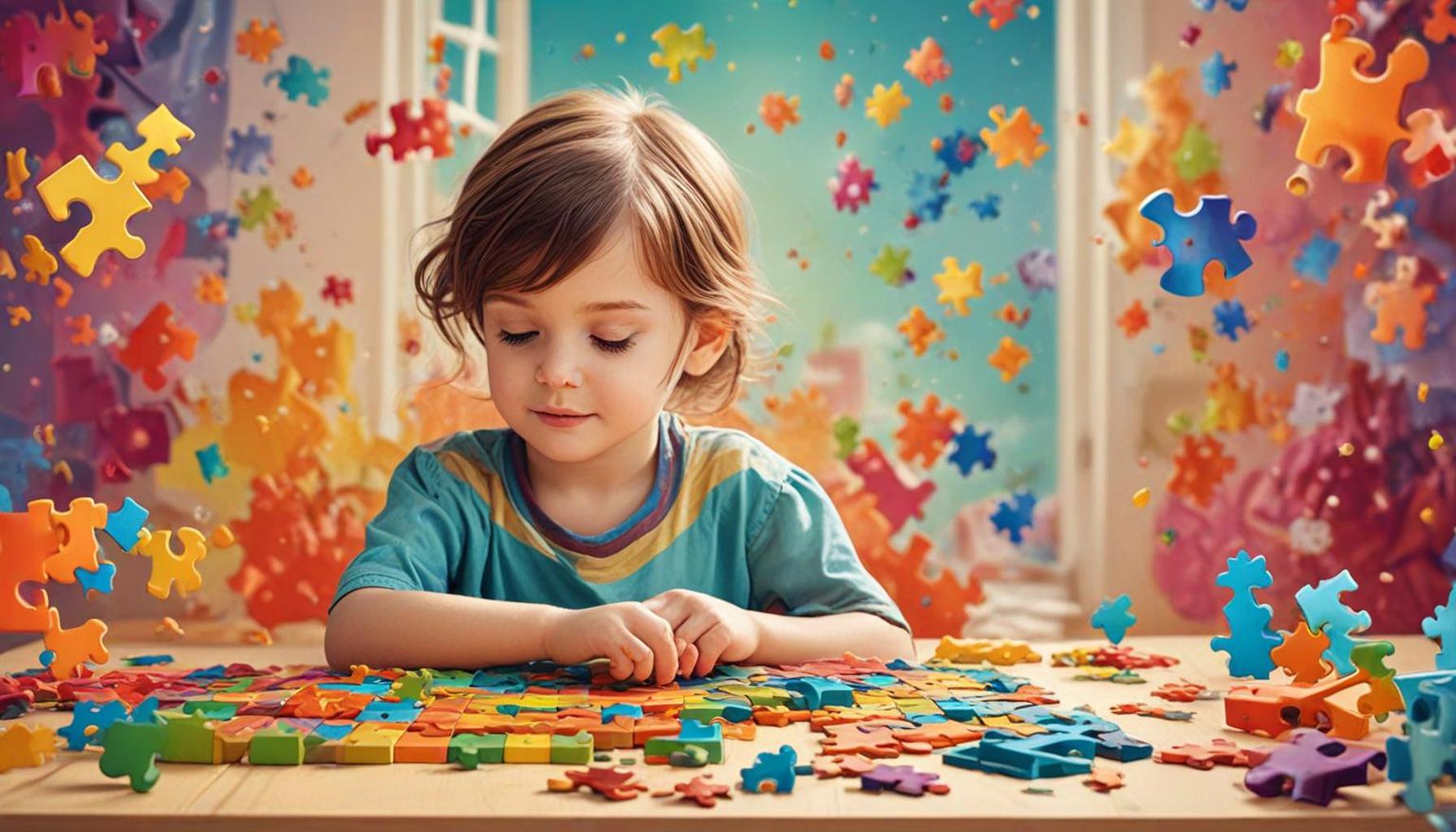How Visual Enigmas Enhance Observation and Analysis Skills in Children

The Importance of Visual Enigmas in Child Development
In an era where children are inundated with visual and auditory stimuli, the ability to observe and analyze becomes paramount. Visual enigmas, such as puzzles, riddles, and optical illusions, serve not only as sources of entertainment but also as vital tools in a child’s developmental arsenal. By engaging with these fascinating images and challenges, children are encouraged to think critically, enhancing their observation skills and awareness of their environment.
Critical Thinking
Critical thinking is the cornerstone of problem-solving. As children interact with visual enigmas, they learn to interpret visual clues and contextual hints. For instance, consider a simple jigsaw puzzle. As a child assembles the pieces, they must analyze shapes and colors, determine where pieces fit, and decipher the bigger picture. This multifaceted approach develops their ability to assess situations and devise strategies, vital skills as they face complex problems in academics and life.
Enhanced Focus
To overcome visual enigmas, children often need to delve into a state of deep concentration. This process not only enhances their ability to focus but also trains their attention span. Engaging with challenging puzzles, particularly visually stimulating ones, fosters persistence and discipline. For example, a child working to solve an optical illusion may initially feel frustrated. However, the eventual “aha!” moment when they crack the illusion fosters a sense of accomplishment, reinforcing their ability to remain engaged with a task for prolonged periods.
Pattern Recognition
Pattern recognition is another cognitive skill honed through visual enigmas. It is a vital part of understanding mathematics, language arts, and science. When children solve riddles that require them to identify relationships between objects or predict outcomes based on visual cues, they are, in fact, training their brains to recognize the underlying structures that govern the world around them. It’s akin to understanding the rhythms in traditional Nigerian music or recognizing motifs in artistic styles, where recognizing patterns can lead to deeper appreciation and insight.
Research indicates that children regularly exposed to visual enigmas not only gain enhanced observation skills but also display stronger cognitive abilities overall. For example, in Nigeria, traditional games such as “Ayo” or story-telling illustrations embedded in local folklore offer unique cultural lenses through which children can explore visual puzzles. Incorporating these familiar themes into contemporary educational frameworks creates enriching contexts that significantly enhance learning outcomes.
Integration of Digital Tools
As technology continues to evolve, integrating digital and interactive visual enigmas into educational curricula can amplify these benefits dramatically. With tablets and educational apps becoming commonplace, children are no longer just passive observers; they become active participants who can manipulate and interact with complex visual puzzles. This active involvement nurtures creativity and critical reasoning—two crucial components for success in today’s fast-paced world. The journey of decoding these enigmas paves the way for a robust educational foundation.
In conclusion, the importance of visual enigmas in child development cannot be overstated. They equip children with essential skills that prepare them for future challenges, making the case for their inclusion in both traditional and modern educational settings more compelling than ever. By engaging with these fascinating tools, children in Nigeria and beyond can unlock the door to a wealth of knowledge and creativity, shaping them into adept thinkers and problem-solvers.
YOU MAY ALSO LIKE: Read read another article
Building Cognitive Foundations through Play
When children interact with visual enigmas, they embark on a journey of discovery that shapes how they understand the world around them. Engaging with challenging images fosters a child’s ability to form connections, think critically, and ultimately fine-tune their observation and analysis skills. This is particularly important in a diverse country like Nigeria, where cultural nuances and educational demands require adaptable and skilful learners.
Engagement through Cultural Context
Incorporating local cultural elements into visual enigmas enhances their relevance and significance. For instance, traditional Nigerian art and folklore can be transformed into interactive puzzles that not only entertain but also educate. When children recognize characters from their cultural stories or local symbols within a riddle, their connection deepens, making analyzation a natural process. By relating to the content, children are more likely to engage actively, fostering a more profound cognitive interaction.
Benefits of Group Activities
Collaborative engagement is another significant aspect of tackling visual enigmas. When children work together through group activities centered on these puzzles, they learn from each other, share different perspectives, and enhance their communication skills. Here are some benefits seen when children engage in group-based visual enigmas:
- Teamwork: Children learn to cooperate and share responsibility in solving challenges.
- Social Skills: Collaborative puzzles enhance interpersonal skills, empathy, and understanding.
- Shared Learning: Exposure to diverse thought processes enriches the collective knowledge of the group.
The communal aspect of problem-solving through visual enigmas mirrors the traditional Nigerian communal lifestyles, where teamwork and collaboration are paramount. This connection not only enhances learning experiences but also cultivates a mindset of collaboration and support among peers.
Development of Spatial Awareness
Visual enigmas are particularly effective in enhancing spatial awareness. Engaging with puzzles that require manipulation of shapes or patterns helps children visualize how different components fit together. Children are not merely solving a puzzle; they are training their minds to assess distance, depth, and size. Activities such as assembling a traditional Yoruba patterned cloth or arranging geometric designs serve as practical illustrations of how spatial reasoning plays a vital role in everyday life.
Furthermore, spatial awareness is crucial for future applications in fields like architecture, science, and mathematics. By incorporating visual enigmas that challenge these skills from a young age, children develop essential competencies that will serve them well in higher education and diverse career paths.
As we explore the various dimensions of visual enigmas, it’s clear that their impact extends far beyond mere entertainment. In nurturing observation and analysis skills, visual enigmas play a pivotal role in preparing children for future challenges in an increasingly complex world.
Visual enigmas serve as powerful tools in the development of children’s observation and analysis skills. These brain teasers encourage children to engage with their surroundings in a more focused manner, enhancing their ability to pick up on details that may otherwise go unnoticed. When children are presented with intriguing puzzles or optical illusions, they are prompted to analyze the components, patterns, and nuances of visual stimuli, leading to improved cognitive processing.By working through visual enigmas, children not only sharpen their observation skills but also develop critical thinking abilities. They learn to approach problems systematically, breaking down complex images into manageable parts and making connections that lead to a deeper understanding of the whole. This practice lays a strong foundation for future learning, as these skills are transferable across various subjects, including mathematics, science, and art.In addition to boosting academic skills, visual enigmas promote creativity and imagination. Children are encouraged to think outside the box and explore multiple perspectives, fostering a sense of curiosity about the world around them. This creative exploration can lead to enhanced self-confidence as children discover their unique approaches to problem-solving.Moreover, participating in visual enigmas can be a collaborative experience. When children tackle puzzles in groups, they learn valuable social skills such as communication, teamwork, and negotiation. Discussing their thoughts and strategies with peers helps them articulate their reasoning, allowing them to absorb and reflect on different viewpoints.In order to provide practical insights, incorporating visual enigmas into daily routines can be done easily and effectively. From engaging in simple riddles during car rides to finding interactive apps or websites dedicated to visual puzzles, parents and educators can seamlessly integrate these activities into children’s lives, ensuring their observation and analysis skills are continually nurtured.
LEARN MORE: This related article may interest you
Encouraging Critical Thinking through Challenges
Visual enigmas are not just fun puzzles; they are valuable tools for nurturing critical thinking skills in children. By posing scenarios that require thoughtful reflection and logical deduction, these enigmas encourage children to actively engage their minds. For instance, puzzles that present a problem to be solved — such as a missing piece in a traditional Nigerian story pattern — compel children to think analytically. They must assess what they already know, identify gaps in their understanding, and strategically reason through various possibilities to arrive at a solution.
Enhancing Pattern Recognition
Recognizing patterns is a crucial component of developing strong observational skills. Visual enigmas serve to strengthen this ability by presenting features and clues that children must identify and connect. For example, consider a puzzle featuring various indigenous symbols that represent elements of Nigerian culture. When children uncover these symbols’ relationships and significance, they sharpen their ability to recognize similar patterns across different contexts. This skill not only aids in arts and crafts but is also foundational for subjects such as mathematics and science.
Moreover, engaging with visual enigmas that involve color patterns and sequences encourages children to discern and predict trends. For instance, children can explore how colors within traditional attire can convey cultural importance or tell a story. Such activities equip them with the ability to analyze situations methodically, thereby enhancing their observational acuity.
The Role of Technology in Modern Puzzles
With the advent of technology, visual enigmas have transformed into digital formats, bringing with them exciting opportunities for learning. Interactive apps and online platforms offer a plethora of puzzles that stimulate visual processing and problem-solving skills. These digital enigmas often incorporate rich graphics and animations that transform the challenge into an engaging experience.
Incorporating technology into education aligns with the increasing prominence of digital literacy in Nigeria. Through platforms that feature local cultural themes, children can dive into challenges that feel both familiar and relatable, keeping their interest alive. Moreover, parents and educators can track progress through these tools, allowing for tailored learning experiences that cater to individual developmental needs.
Real-World Applications of Analytical Skills
The skills honed through visual enigmas extend far beyond the classroom. As children learn to observe and analyze their surroundings critically, they begin to apply these methods to real-world situations. For example, solving visual enigmas equips children with the ability to navigate challenges they may encounter during group activities or community projects. This is particularly valuable in Nigeria, where communal living and collective problem-solving are celebrated aspects of society.
Furthermore, as children develop the ability to synthesize information from their surroundings, they cultivate heightened awareness of their social environment. Engaging with visual enigmas promotes a broader understanding of community dynamics and cultural diversity, which is essential in a nation as multifaceted as Nigeria. As they analyze various perspectives, children become more open-minded, fostering a culture of inclusion and mutual respect.
As seen, visual enigmas are instrumental in promoting a child’s cognitive growth. By fostering critical thinking, pattern recognition, and practical applications of analytical skills, these puzzles prepare children for future challenges in an increasingly intricate world. The incorporation of technology and local culture into the mix further enriches the learning experience, making it both enriching and accessible.
SEE ALSO: Click here to read another article
Unlocking Potential Through Visual Enigmas
In conclusion, the impact of visual enigmas on the development of children’s observation and analysis skills cannot be overstated. As discussed, these engaging puzzles serve multiple purposes: they stimulate critical thinking, enhance pattern recognition, and impart valuable real-world applications of analytical abilities. By immersing children in problem-solving challenges, particularly those rooted in cultural contexts, we enable them to cultivate essential cognitive skills that will serve them throughout their educational journeys and beyond.
Moreover, the integration of technology into these puzzles presents a dynamic way to engage today’s digital-savvy children. The use of interactive apps and online platforms not only makes learning more enjoyable but also facilitates personalized learning experiences that cater to each child’s unique developmental needs. As children interact with visually stimulating content based on their rich cultural heritage, they fortify their cognitive skills while enjoying a sense of connection to their roots.
Finally, as children embrace the challenge of visual enigmas, they unlock their potential to navigate an increasingly complex world with confidence and insight. The skills acquired through these puzzles promote social awareness and inclusivity, which are crucial in Nigeria’s diverse society. By investing time and resources into the cultivation of observation and analysis skills through visual enigmas, we are not just fostering individual growth; we are nurturing the innovators and problem solvers of tomorrow.


